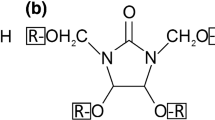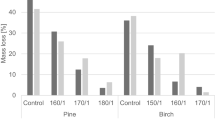Abstract
Wood has no inherent natural resistance against agents of biodegradation. We evaluated the effects of metal bath heat treatment (MBHT) on decay resistance and dimensional stability of Chinese parasol (Firmiana simplex) and Chinese fir (Cunninghamia lanceolata) wood. A low melting point alloy was used as heating medium in the treatment of the wood samples at 150, 180, and 210 °C for 2, 4, and 8 h. Heat-treated and control samples were exposed to brown rot fungus (Poria placenta) and white rot fungus (Coriolus versicolor) for decay resistance testing and anti-swelling efficiency (ASE). The improved decay resistance with increase temperatures with low mass losses of 7.3 and 7.3% for F. simplex, and 3.9 and 3.6% for C. lanceolata at 210 °C for 8 h against Coriolus versicolor and Poria placenta, respectively. ASE indicated that MBHT contributed to improved dimensional stability of both wood species after treatment. Scanning electron micrograph results indicate that metal bath-treated samples showed strong decay resistance. Therefore, our approach to thermally modify wood should be explored to overcome the energy utilization by using low melting point alloy for the heat treatment of wood.




Similar content being viewed by others
References
ASTM D 2017 (2005) Standard method of accelerated laboratory test of natural decay resistance of woods. West Conshohocken
Bazyar B (2012) Decay resistance and physical properties of oil heat treated aspen wood. BioResources 7(1):0696–0705
Boonstra MJ, Rijsdijk JF, Sander C, Kegel E, Tjeerdsma B, Militz H, Van Acker J, Stevens M (2006) Microstructural and physical aspects of heat treated wood. Part 1. Softwoods. Maderas. Ciencia y tecnología 8(3):193–208
Boonstra M, Van Acker J, Kegel E, Stevens M (2007) Optimisation of a two-stage heat treatment process: durability aspects. Wood Sci Technol 41(1):31–57
Burmester A (1981) Dimensional stabilisation of wood. The International Research Group on Wood Preservation. Document no. IRG/WP, 3171
Calonego FW, Severo ETD, Furtado EL (2010) Decay resistance of thermally-modified Eucalyptus grandis wood at 140°C, 160°C, 180°C, 200°C and 220°C. Bioresour Technol 101(23):9391–9394
Candelier K, Dumarçay S, Pétrissans A, Gérardin P, Pétrissans M (2013) Comparison of mechanical properties of heat treated beech wood cured under nitrogen or vacuum. Polydegrad Stab 98(9):1762–1765
Chaouch M, Pétrissans M, Pétrissans A, Gérardin P (2010) Use of wood elemental composition to predict heat treatment intensity and decay resistance of different softwood and hardwood species. Polym Degrad Stab 95(12):2255–2259
Chen Y, Fan Y, Gao J, Stark NM (2012) The effect of heat treatment on the chemical and color change of black locust (Robinia pseudoacacia) wood flour. BioResources 7(1):1157–1170
Cho CH, Lee KH, Kim JS (2008) Micromorphological characteristics of bamboo (Phyllostachys pubescens) fibers degraded by a brown rot fungus (Gloeophyllum trabeum). J Wood Sci 54(3):261–265
De Vetter L, Van Acker J (2005) Standard testing of organosilicon compounds as wood modification agents. In: Wood modification: processes, properties and commercialisation. The second European conference on wood modification. 6th–7th October, pp 232–241
Del Menezzi CHS, de Souza RQ, Thompson RM, Teixeira DE, Okino EYA, da Costa AF (2008) Properties after weathering and decay resistance of a thermally modified wood structural board. Int Biodeterior Biodegrad 62(4):448–454
Dirol D, Guyonnet R (1993a) The improvement of wood durability by retification process. In: The International Research Groups on Wood Preservation. Document no. IRG/WP 93-40015, Section 4. 24 Annual meeting, May, pp 16–21
Dirol D, Guyonnet R (1993b) The improvment of wood durability by retification process. In: The International Research Group on Wood Preservation_Section 4_Report prepared for the 24 Annual Meeting, pp 1–11
Dong Y, Yan Y, Wang K, Li J, Zhang S, Xia C, Shi SQ, Cai L (2016) Improvement of water resistance, dimensional stability, and mechanical properties of poplar wood by rosin impregnation. Eur J Wood Wood Prod 74(2):177–184
Dubey MK, Pang S, Walker J (2012) Oil uptake by wood during heat-treatment and post-treatment cooling, and effects on wood dimensional stability. Eur J Wood Wood Prod 70(1–3):183–190
Erakhrumen A (2014) Assessing the effectiveness of neem seed oil-treatment for split-bamboo (Bambusa vulgaris) against Pycnoporus sanguineus based on tensile strength properties. J Am Bamboo Soc 36
Esteves B, Domingos I, Pereira H (2008) Pine wood modification by heat treatment in air. BioResources 3(1):142–154
Esteves B, Videira R, Pereira H (2011) Chemistry and ecotoxicity of heat-treated pine wood extractives. Wood Sci Technol 45(4):661–676
GB/T 13942.1-2009 Chinese Standard of Durability of wood. Part 1: method for laboratory test of natural decay resistance. The People’s Republic of China
Hakkou M, Pétrissans M, Gérardin P, Zoulalian A (2006) Investigations of the reasons for fungal durability of heat-treated beech wood. Polym Degrad Stab 91(2):393–397
Hill CA (2006) Modifying the properties of wood. Wood modification: chemical, thermal and other processes, San Francisco, pp 19–44
Hill CA (2007) Wood modification: chemical, thermal and other processes. Wiley, New York
Hill CA, Farahani MM, Hale MD (2004) The use of organo alkoxysilane coupling agents for wood preservation. Holzforschung 58(3):316–325
Homan WJ, Jorissen AJ (2004) Wood modification developments. Heron 49(4):360–369
Huang X (2012) Study on the degradation mechanism of heat-treated. Doctoral dissertation, Chicoutimi, University of Quebec
Inari GN, Pétrissans M, Pétrissans A, Gérardin P (2009) Elemental composition of wood as a potential marker to evaluate heat treatment intensity. Polym Degrad Stab 94(3):365–368
Jesus MAD, Morais JWD, Abreu R, Cardias MDFC (1998) Durabilidade natural de 46 espécies de madeira amazônica em contato com o solo em ambiente florestal
Kamdem D, Pizzi A, Jermannaud A (2002) Durability of heat-treated wood. Holz als Roh-und Werkstoff 60(1):1–6
Kim GH, Yun KE, Kim JJ (1998) Effect of heat treatment on the decay resistance and the bending properties of radiata pine sapwood. Mater Org 32(2)
Kocaefe D, Chaudhry B, Poncsak S, Bouazara M, Pichette A (2007) Thermogravimetric study of high temperature treatment of aspen: effect of treatment parameters on weight loss and mechanical properties. J Mater Sci 42(3):854–866
Mai C, Militz H (2004) Modification of wood with silicon compounds. Treatment systems based on organic silicon compounds—a review. Wood Sci Technol 37(6):453–461
Militz H (2002) Heat treatment technologies in Europe: scientific background and technological state-of-art. In: Proceedings of conference on” enhancing the durability of lumber and engineered wood products”, February, pp 11–13
Militz H, Tjeerdsma B (2001) Heat treatment of wood by the “Plato-Process”. In: Rapp AO (ed) Review on heat treatments of wood. BFH, Hamburg, pp 25–35
Momohara I, Ohmura W, Kato H, Kubojima Y (2003) Effect of high-temperature treatment on wood durability against the Brown-rot fungus, Fomitopsis palustris, and the térmite, Coptotermes formosanus. In: 8th international IUFRO wood drying conference, pp 284-287
R Core Team (2014) R: a language and environment for statistical computing. R Foundation for Statistical Computing, Vienna. http://www.R-project.org/
Rapp A (2001) Review on heat treatments of wood. In: Proceedings of special seminar, Antibes, France
Scheiding W, Direske M, Zauer M (2016) Water absorption of untreated and thermally modified sapwood and heartwood of Pinus sylvestris L. Eur J Wood Prod 74(4):585–589
Stamm AJ, Baechler R (1960) Decay resistance and dimensional stability of five modified woods. For Prod J 10(1):22–26
Šušteršic Ž, Mohareb A, Chaouch M, Pétrissans M, Petrič M, Gérardin P (2010) Prediction of the decay resistance of heat treated wood on the basis of its elemental composition. Polym Degrad Stab 95(1):94–97
Tjeerdsma B, Boonstra M, Pizzi A, Tekely P, Militz H (1998) Characterisation of thermally modified wood: molecular reasons for wood performance improvement. Holz als Roh-und Werkstoff 56(3):149–153
Tjeerdsma B, Stevens M, Militz H, Van Acker J (2002) Effect of process conditions on moisture content and decay resistance of hydro-thermally treated wood, Holz. Holzverwert 5:94–99
Viitanen H, Jämsä S, Paajanen L, Nurmi A, Viitaniemi P (1994) The effect of heat treatment on the properties of spruce. A preliminary report. Document-the International Research Group on Wood Preservation, Sweden
Weiland JJ, Guyonnet R (2003) Study of chemical modifications and fungi degradation of thermally modified wood using DRIFT spectroscopy. Holz als Roh-und Werkstoff 61(3):216–220
Welzbacher C, Rapp A (2002) Comparison of thermally modified wood originating from four industrial scale processes-durability. The International Research Group on Wood Preservation. Document no. IRG/WP, 02-40229
Welzbacher RC, Brischke C, Rapp A (2007) Influence of treatment temperature and duration on selected biological, mechanical, physical and optical properties of thermally modified timber. Wood Mater Sci Eng 2(2):66–76
Author information
Authors and Affiliations
Corresponding author
Additional information
Project Funding: This work was financially supported by the Special Scientific Research Fund for Public Service Sectors of Forestry (Grant No. 201504603), Science and Technology Projects of Fujian Province (2014NZ003) and the National Natural Science Foundation of China (Grant Nos. 31370560, 31170520).
The online version is available at http://www.springerlink.com
Corresponding Editor: Yu Lei.
Rights and permissions
About this article
Cite this article
Okon, K.E., Lin, F., Chen, Y. et al. Decay resistance and dimensional stability improvement of wood by low melting point alloy heat treatment. J. For. Res. 29, 1797–1805 (2018). https://doi.org/10.1007/s11676-017-0537-x
Received:
Accepted:
Published:
Issue Date:
DOI: https://doi.org/10.1007/s11676-017-0537-x




